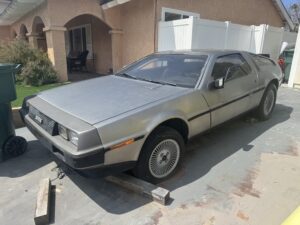
This 1981 DMC DeLorean VIN Verification was done by our team member in Huntington Beach, Ca. on 5/7/2025

This 1981 DMC DeLorean VIN Verification was done by our team member in Huntington Beach, Ca. on 5/7/2025
The 1981 DeLorean DMC-12 is one of the most iconic vehicles in automotive history, known as much for its futuristic stainless-steel styling and gull-wing doors as it is for its pop culture legacy, particularly in the Back to the Future film series. Designed by former GM executive John Z. DeLorean, the car was a bold and unconventional entry into the sports car market, offering a unique blend of European engineering and American ambition.
The DMC-12 was the brainchild of John DeLorean, who envisioned a revolutionary sports car with safety, style, and innovation at its core. After founding the DeLorean Motor Company (DMC) in 1975, he secured funding and set up a factory in Dunmurry, Northern Ireland, with government assistance. Production began in early 1981. The “DMC-12” name originated from its intended $12,000 price tag, though it launched closer to $25,000.
Despite its bold promise, the DeLorean project was short-lived. Only about 9,000 units were produced between 1981 and 1983 before the company collapsed due to financial troubles and controversy surrounding DeLorean himself. The 1981 model year was the first and most widely produced version, and it forms the core of the DeLorean’s mystique.
The 1981 DeLorean DMC-12 featured a rear-mounted 2.85L PRV (Peugeot-Renault-Volvo) V6 engine, which delivered:
130 horsepower
153 lb-ft of torque
0–60 mph in approximately 9.5–10.5 seconds, depending on transmission
Transmission options included:
5-speed manual (standard and more performance-oriented)
3-speed automatic (optional, reduced acceleration performance)
While the power output was modest, especially compared to its exotic appearance, the DeLorean was engineered for balance and handling rather than outright speed.
The DeLorean’s standout feature is its brushed stainless-steel body panels—resistant to rust and visually striking. Key design highlights include:
Gull-wing doors with gas strut supports
Fiberglass underbody mounted to a steel backbone chassis (Lotus-inspired design)
Lotus-tuned suspension with independent front and rear setup
14″ front and 15″ rear turbine-style alloy wheels
Inside, the cabin was driver-focused but minimalist, featuring:
Leather upholstery (gray or black)
Air conditioning, power windows, and AM/FM cassette stereo
Analog instrument cluster and rotary climate controls
Two-seat configuration with limited rear cargo space behind seats
The 1981 DeLorean DMC-12 was offered in essentially one trim, though customers could choose between:
Manual or automatic transmission
Gray or black interior
Early 1981 models (known as “early VIN” cars) had unique features such as hood gas flaps and non-staggered wheels, which were phased out mid-year. Later in production, minor cosmetic and quality control refinements were introduced, but no major trim differentiation was implemented by the factory.
For its time, the DeLorean was equipped with several advanced and safety-conscious features:
Steel backbone chassis for crash strength
Collapsible steering column
Four-wheel disc brakes
Rack and pinion steering
However, it lacked modern safety systems like airbags, ABS, or traction control, and had limited rear visibility due to design constraints.
The DeLorean offered reasonable fuel economy for a sports car of its time:
EPA estimates:
Manual: ~21 MPG highway / ~17 MPG city
Automatic: ~19 MPG highway / ~15 MPG city
With a 13.5-gallon fuel tank, it offered a driving range of approximately 250–300 miles per tank under mixed conditions.
In 1981, the DMC-12 competed with other European and American sports cars such as:
Chevrolet Corvette C3 – More powerful V8 but less exotic styling
Porsche 924/911 – Better performance and handling, but more expensive
Lotus Esprit – Technically superior and similarly exotic
BMW 6 Series and Alfa Romeo GTV6 – Practical GTs with European refinement
While the DeLorean couldn’t match competitors in performance, it stood out for its design, exclusivity, and media attention, making it more of a statement piece than a track machine.
Original MSRP (1981):
Around $25,000 (equivalent to over $80,000 in 2025 dollars)
Today’s collector market:
Fair condition: ~$30,000–$45,000
Good condition: ~$50,000–$65,000
Fully restored or low-mileage models: $70,000–$95,000+
Special provenance (e.g., screen-used or early VIN): $100,000+
Achieved cult status through the Back to the Future film trilogy
Recognized as a design icon of the 1980s by multiple automotive historians
Displayed in museums worldwide, including the Petersen Automotive Museum and the National Motor Museum (UK)
Continues to inspire restomods, EV conversions, and a new generation of DeLorean branding efforts
Need a VIN Verification? We are licensed to complete the REG 31 form. Call to get your car, truck or motorcycle verified today!
© 2025 QUICK VIN VERIFICATION. All rights reserved.